1956 CHEVROLET Nomad
Finding Trim for an Uncommon Car Like This One Can Be Daunting and Really Slow Down a Project. That Broken Wire Didn’t Help Things Either…
JOHN MILTON CAN pin down almost exactly the moment when he completed the restoration of his 1956 Chevy Nomad.
“I got it done in ’14,” he said, “because I got a Junior award at Hershey last October and I finished it something like 24 hours before I took it there. No lie.”
It might have gotten to that moment with more time to spare were it not for a factor that every restorer knows too well.
“Gremlins,” Milton continued. “I thought I was all done and I’m driving down the road and it’s cutting in and cutting out. I couldn’t tell whether the engine was running or not. Part of my problem is that my hearing isn’t so good anymore and I actually thought there was an issue with the rear end. That was on Saturday (days before the annual Antique Automobile Club of America major meet at Hershey, Pennsylvania). I tore the rear end all apart and I swapped out the pumpkin from my 65,000-mile parts car, put it all back together again and for about the first 10 miles, I thought the problem was solved.”
Naturally, it wasn’t and so when that became apparent and he was able to identify it as an engine problem, he replaced the coil. The breaker plate in the distributor seemed to have some play and so he replaced that, too. Neither one provided the cure, nor did the vacuum advance that he swapped in next. The distributor then came out again.
“I had a vacuum pump on it and I was taking it down with a meter,” Milton recalled, “when all of a sudden, the continuity opened up between the input wire and the contact points. The wire that went from the distributor to the contact points was broken inside the insulation, so when the vacuum advance rotated the distributor, it would open up that wire, which would shut off the engine. When it was cold, the insulation was stiff enough to hold it together and once the engine warmed up and that insulation got warm, it separated.”
Despite the Nomad’s best efforts, the plan to leave Tuesday morning for the Hershey meet was back on track Sunday night, but that’s nothing compared to the rest of the story behind the car.
A Corvette Station Wagon? Well, No…
In 1954 a Nomad concept vehicle was unveiled at General Motors’ Motorama as one of styling chief Harley Earl’s “dream cars.” It followed the 1950 introduction of Ford’s Country Squire two-door station wagon and in concept form it combined the nose and sides of the first-generation Corvette with what today is the familiar Nomad roof profile.
But when the Nomad arrived as a 1955 production model, it was based not on the Corvette, but on the full-size Chevrolet which was fine because that meant everything about it was new.
The production model’s slab sides and uncomplicated treatments at front and rear provided the perfect platform for the Motorama Nomad’s greenhouse and rear. The thick, forward-leaning B-pillar visually overwhelmed the upright windshield post and vent window while the almost-uninterrupted side glass behind it curved to meet the similarly sloping pillar at the rear. The tailgate with its chromed vertical strips, the opened rear wheel well and the fact that it was a two-door all enhanced the sporty image, and since 1955 brought the 265 V-8, it was an image that could be backed with performance.
Nomad’s Brief Run In the Showrooms
While it certainly could serve as the family station wagon and do much of what a wagon might be called on to do, the Nomad had two marketplace weaknesses. It fell short on practicality — in this case, because it was a two-door and offered less cargo space than its conventional siblings did — and it was not cheap. At $2571, it was the most expensive Chevy other than the Corvette and topped the orthodox high-end Beauville wagon by $309. Chevrolet sold just 8386 Nomads in 1955, beating only the Corvette, but it was an idea too compelling to drop and so the Nomad returned for 1956 with all of the annual styling updates and a rear wheel well reshaped to match the rest of the line. Now priced at $2608, sales still were below everything but the Corvette.
Despite a major restyling from the beltline down, sales in 1957 fell to 6103 from 7886 the previous year and that was that.
The Nomad returned in 1958 still at the top of the wagons and still not cheap, but it no longer was a two-door. Chevy had learned that even a high-end station wagon really did need to be practical.
So, Which One’s the Parts Car?
The 1955-57 Chevrolets never had to be discovered by enthusiasts and collectors because they never really fell from favor with hobbyists, and while Milton was not one of those who scooped up his Nomad at what now seems like a bargain price — a 1975 survey places a 1955 Nomad’s cost as $600 in “fair” condition — he’s still had it for a while.
But as mentioned above, there’s a story behind this car.
“I bought it in 1999,” Milton said. “I was looking for a Nomad and I went to the Macungie (Pennsylvania) street rod show with my wife, Lisa, and on the way down I told her ‘we’re going to buy a Nomad.’ And I bought a Nomad down there and I got it home and it was missing a lot of parts.
“This was a Nomad that was a drag car. So I was looking for a parts car and this guy had a Nomad listed down in Louisville. I called and told him I was interested in the car and asked whether it had power steering and power brakes. He said ‘yeah, it’s loaded.’ I said ‘is it a Power Pack car?’ He said ‘it’s loaded. It’s got factory air, power windows, power seats. I told you, it’s loaded.’”
He didn’t learn enough from photos the seller sent, so he drove from his Vestal, New York, home to Louisville to see the car for himself. It was, he recalled, “pretty sorry” with serious rust problems and body damage, but nearly everything that made it a loaded car was there. He bought it and as happens in plenty of restorations, the plan changed.
“Instead of that being the parts car,” Milton said, “the original Nomad turned into the parts car. Because this car had also been hit on the driver’s side and the cowl was pushed in pretty good, I ended up using the body off of the Macungie car and the rest of the stuff off the Louisville car.”
Finding a Part Here, Another Part There, and Fabricating Some as Well
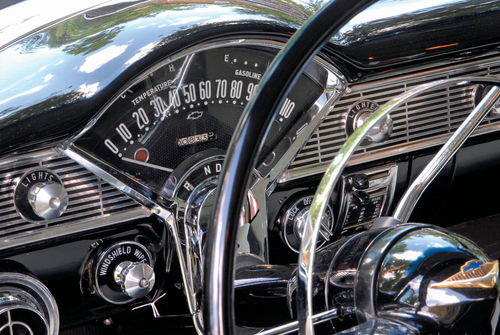
As a drag car, the Macungie Nomad had been spared major rust, but its sheet metal had been damaged when pieces were cut away. The Louisville car provided several replacements, as did Hershey swap meet vendors, online auctions and Milton’s own skills at fabrication. Full quarter panels are available only for the 1955 and ’57 Nomads, he said, and that meant he needed to rebuild the Macungie shell’s modified lower quarters, a task for which there’s really no easy way out.
“I bought a set of fender skirts,” he said, “so that I could get the rear wheel-openings correct. And I bought the repair panels for the quarter panels and mounted them to the body with basically zip screws and with the fender skirts clamped in there so that the whole thing would be correct. I did the rocker panels at the same time...
“The liftgate my wife found at Hershey. We slogged through the mud and she said ‘isn’t that a liftgate over there?’ I went over and there was not a pit on it and it was straight. All I had to do was give the guy $1200 to re-plate it.”
The Macungie body, obviously, had very little interior. Most of what was in the Louisville car was restorable, but even that left pieces missing.
“What wasn’t there on either car,” Milton said, “was all the stainless in the cargo area. Because it’s got the linoleum-type interior, it’s got a stainless frame that goes all around the cargo area and then it goes around the spare tire cover. Then the seat that folds forward has stainless that goes all around it.
“Even on the four-door wagon, the Bel Air level has all that stainless, but the two stainless runners that go down the outside are Nomad-unique. So I bought a ’57 four-door wagon just for that cargo stainless and the car broke in two as we were pulling it onto the trailer.”
The two small pieces that he still didn’t have were found on eBay, as were some other hard-to-find components.
“The pulley off of the water pump and the harmonic balancer were both missing,” Milton said, “and they’re air conditioning-specific. And the yoke, which is a band that holds the airbox to a flange on the firewall, was missing. A friend of mine called and said ‘there’s a bunch of air parts listed on eBay.’ (The seller) didn’t have the yoke. He didn’t list that, but he listed the water pump pulley and the harmonic balancer, so I sent him an e-mail, ‘do you have the yoke?’ ‘Yeah,’ he said, ‘but I won’t sell it separately. I’m selling it with the airbox and the assembly that mounts on the firewall.’
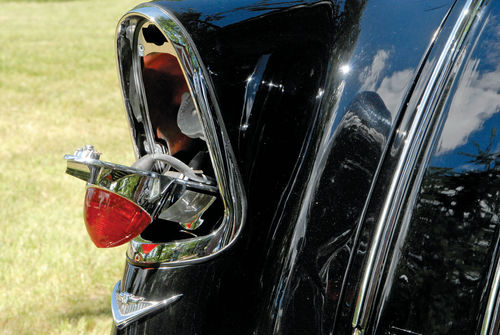
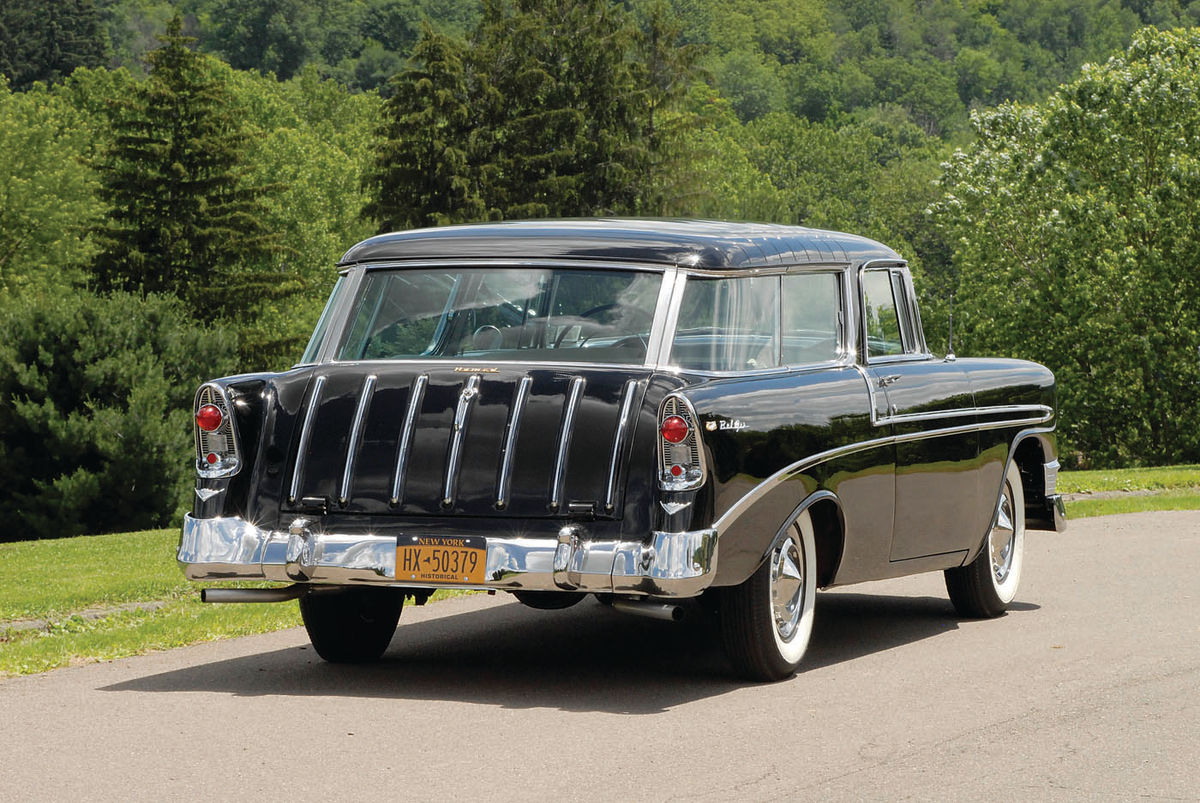
“I bought that and then I took all of the air components, which would be the evaporator, the condenser, the drier and compressor and sent them to Vintage Air (Vintageair.com). They rebuilt everything and converted it to R134a.”
The Nomad’s air conditioning requires other specific parts, he explained, including a firewall-mounted circuit breaker and on early-1956 V-8 cars, an exhaust manifold incorporating a mount for the compressor. Since the airbox blocks access to the Powerglide’s dipstick, the transmission on an air-conditioned car has a side cover with a removable plug so that the fluid level can be checked.
“On an air car,” Milton continued, “you’ve got a throttle cable. If you pull up to a red light and your air compressor is engaged, the idle might drop down to where it would stall, so you can pull this throttle cable out. That was General Motors’ solution to the additional load on the engine. There’s a little clamp that holds that cable where it goes through the firewall.”
His work on the body and the air conditioning left the chassis and drivetrain, which came from the Louisville car.
“I took it down to the bare chassis,” Milton recalled, “and redid the frame and the rear axle and the front suspension, the engine, transmission and had a complete chassis ready to roll. Anything that was a replaceable wear item was worn out, so it’s got new springs and new ball joints and new tie rod ends, brake lines, gas lines, a new gas tank.”
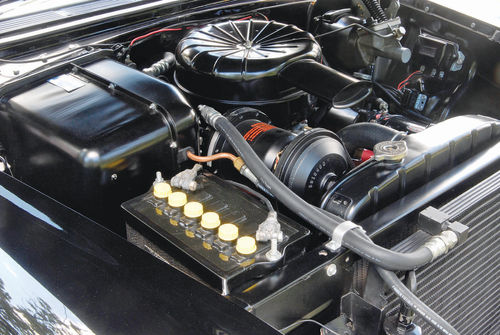
Chevys Aren’t Hard to Find… But Nomad Trim Is a Challenge
The fact that it’s a Nomad and has air-conditioning sets it apart, but it’s still a 1956 Chevy and that car’s popularity has its advantages.
“I had actually bought a ’56 four-door,” Milton said, “an unmolested original vehicle. I was going to use it as an additional parts car for the Nomad project and then I decided that I didn’t want to tear it all apart because it was too good for that, so that was one of my ‘factory assembly manuals.’ I’d just go down and look at how it was done on that car. And I had a friend who was, I would say, a fairly knowledgeable expert on Tri-Five cars because he had obsessed on them his whole life. He knew quite a bit about them.”
By this time, of course, Milton knows quite a bit about them, too, and his first piece of advice to a potential owner isn’t very surprising.
“You would want to find one that is as complete as possible from the trim standpoint,” he said, “and not just the paint dividers on the side of the car that are Nomad-unique and very expensive.”
Some of the side trim interchanges with that of a Bel Air two-door hardtop, he said, but the chromed bows on the headliner are Nomad-only as are the gates and their trim. The rear seat fits other wagons, the front seat fits two-doors and both are trimmed for a Nomad. Other than the windshield and vent windows in the doors, the glass fits no other Chevy.
Problem areas to be checked carefully for rust are about the same as those on other 1956 Chevrolets and, for that matter, on most mid-1950s cars. The list includes the floor pan, door bottoms, rocker panels, quarter panels and the fenders both above the headlights and behind the wheel wells.
“They claim that the bottoms of the tailgates rust,” Milton said. “I was fortunate. Actually, on both of the cars that I got, the bottoms of the tailgates were very solid.”
Slowed Down By a Fire, an Australian Ute and a ’39 Truck…
Mechanically, a Nomad is pure 1956 Chevrolet under the skin and that means it’s extensively supported with parts and information. Its drivetrain lies somewhere between bulletproof and indestructible.
As a dyed-in-the-wool Chevy man, Milton knew much of that before he bought the Macungie car and learned the rest as the restoration went on, but even that’s not the end of his Nomad’s story.
“There were a few distractions along the way,” he said. “The barn that I had all of my other cars stored in burned down. The reason why this didn’t burn is that it was in (the shop) and I was working on it. So then I had to recover from that mess. I found that ute and I wanted to do that and get it to drive right away, so the time I spent on that was taken away from (the Nomad) and then I went back on the Nomad.”
The fire and the restoration of the 1952 Chevy ute — Australia’s interpretation of the El Camino/Ranchero concept — were not the only interruptions. There was the 1939 Chevy cab-over-engine that he restored to replace one lost in the fire and then there was the woodie whose chassis and sheet metal he restored before handing it over to a woodworker. Finally, he dealt with the more than 100 trees that a windstorm had toppled on his property.
“But I got tired of everybody asking me when I was going to finish that Nomad,” he said, “and I finally finished it.”
He’d made the car drivable before it was completed so that he could find and correct problems as the work progressed. For example, after he’d had the transmission rebuilt, it almost immediately refused to upshift automatically. He could upshift it manually, he said, and the transmission’s service book pointed to dirt in the valve body as the cause. That meant a trip back to the rebuilder, who cured the lack of shifting and insisted that Milton take the car for a test drive because the staff preferred not to go out on the road with it.
It was fine, he said, but what about that wire whose failure almost ran out the clock as the Hershey meet was approaching?
“I had probably put 700 miles on it,” Milton said, “before that thing raised its ugly head.”
He still has the wire and it’s not going anywhere. Neither is the Nomad.
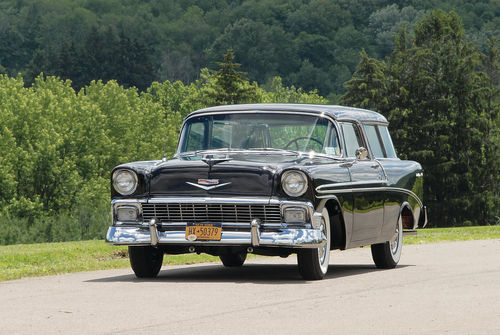
A Keeper and a Conversation Piece
“I’m not going to get rid of this car,” he said. “I have other cars I would sell before I would consider selling this.”
For several reasons, his decision is the right one. It’s ready for any trip, he said, and 15 to 16 miles per gallon is tolerable.
“It handles like a new ’56 Chevy,” Milton said, “so it’s not like it’s all over the road. You would be comfortable (driving) it.”
While the seats provide enough support to make an all-day drive realistic, he said you also have to be prepared for numerous encounters with others on the road. The Nomad’s uncommon styling, lack of two-toning and its combination of considerable brightwork on black paint all but guarantees constant attention.
“You can tell,” he said, “when you’re going down the road and somebody starts to pass you and takes a long time, then they get up alongside of you and give you a thumbs-up.”
It’s not a good car to drive when in a hurry, as he said stops often result in conversations. Nevertheless, he said that those in their 50s or older would probably be the youngest among non-enthusiasts to identify the car correctly because they would remember Nomads. Reactions to his wife’s car, oddly enough, suggest that some of those who can name it might be just doing so with lucky guesses.
“My experience — and this is based on Lisa’s ’56 four-door wagon — is that everybody thinks that a Chevy wagon is a Nomad,” he observed.
That Mysterious Gas Filler
In addition, at one time any ’56 Chevy was good for some occasional amusement regardless of whether someone knew what it was or didn’t care in the least.
“The fun part,” Milton confessed, “was pulling into a full-service gas station and having somebody come back and ask where the gas filler is. But there aren’t a lot of full-service gas stations anymore.”
No doubt, the small lever that opened the left taillight to reveal the filler stumped more than one attendant in the Nomad’s day, but there’s no way to know how often or in which gas stations it happened. It’s a minor detail, but details are important.
“Any car I own,” Milton said, “I wish it could tell its story. That would be so interesting.”
















